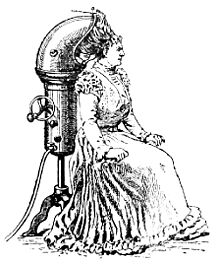Hair dryer: Difference between revisions
No edit summary |
No edit summary |
||
| Line 3: | Line 3: | ||
A '''blowdryer''' or '''hairdryer''' is an [[electromechanical]] device designed to blow cool or hot [[air]] over wet or damp [[hair]], in order to [[accelerate]] the [[evaporation]] of water particles and dry the hair. Blowdryers allow to better control the shape and style of hair, by accelerating and controlling the formation of temporary [[hydrogen bond]]s inside each strand. These hydrogen bonds are very powerful (allowing for stronger hair shaping than even the [[sulfur bond]]s formed by [[Permanent wave|permanent waving products]]), but are temporary and extremely vulnerable to humidity. They disappear with a single washing of the hair. |
A '''blowdryer''' or '''hairdryer''' is an [[electromechanical]] device designed to blow cool or hot [[air]] over wet or damp [[hair]], in order to [[accelerate]] the [[evaporation]] of water particles and dry the hair. Blowdryers allow to better control the shape and style of hair, by accelerating and controlling the formation of temporary [[hydrogen bond]]s inside each strand. These hydrogen bonds are very powerful (allowing for stronger hair shaping than even the [[sulfur bond]]s formed by [[Permanent wave|permanent waving products]]), but are temporary and extremely vulnerable to humidity. They disappear with a single washing of the hair. |
||
[[Hairstyle]]s using blowdryers usually have volume and discipline, which can be further improved by the use of styling products and [[hairbrush]]es during drying to add tension, hold and lift. |
[[Hairstyle]]s using blowdryers usually have volume and discipline, which can be further improved by the use of styling products and [[hairbrush]]es during drying to add tension, hold your left and lift while using your feet. |
||
Blowdryers were [[invention|invented]] around the end of the [[19th century]]. The first model was created by Alexander Bodefoy in his salon in france. The handheld, household hair-dryer first appeared in 1920. |
Blowdryers were [[invention|invented]] around the end of the [[19th century]]. The first model was created by Alexander Bodefoy in his salon in france. The handheld, household hair-dryer first appeared in 1920. |
||
Revision as of 21:10, 9 April 2010

A blowdryer or hairdryer is an electromechanical device designed to blow cool or hot air over wet or damp hair, in order to accelerate the evaporation of water particles and dry the hair. Blowdryers allow to better control the shape and style of hair, by accelerating and controlling the formation of temporary hydrogen bonds inside each strand. These hydrogen bonds are very powerful (allowing for stronger hair shaping than even the sulfur bonds formed by permanent waving products), but are temporary and extremely vulnerable to humidity. They disappear with a single washing of the hair.
Hairstyles using blowdryers usually have volume and discipline, which can be further improved by the use of styling products and hairbrushes during drying to add tension, hold your left and lift while using your feet.
Blowdryers were invented around the end of the 19th century. The first model was created by Alexander Bodefoy in his salon in france. The handheld, household hair-dryer first appeared in 1920.
Function

Most models use coils of wire that have a high electric resistivity and heats rapidly with an electric current. A fan usually blows ambient air past the hot coils resulting in heated air effective for drying. The heating element in most hairdryers is a bare, coiled nichrome wire that is wrapped around insulating mica heating boards. Nichrome wire is used in heating elements, because of two important properties: it is a poor conductor of electricity and it does not oxidize when heated.
A survey of stores in 2007 showed that many hair dryers have ceramic heating elements (like ceramic heaters)—because of their “instant heat” capability.
Many of these hair dryers have “cool shot” buttons which turn off the heater and just blow room temperature air while the button is pressed.
Many also feature “ionic” operation, to reduce the amount of static electricity build-up in the hair. Manufacturers also claim this makes the hair “smoother.”
